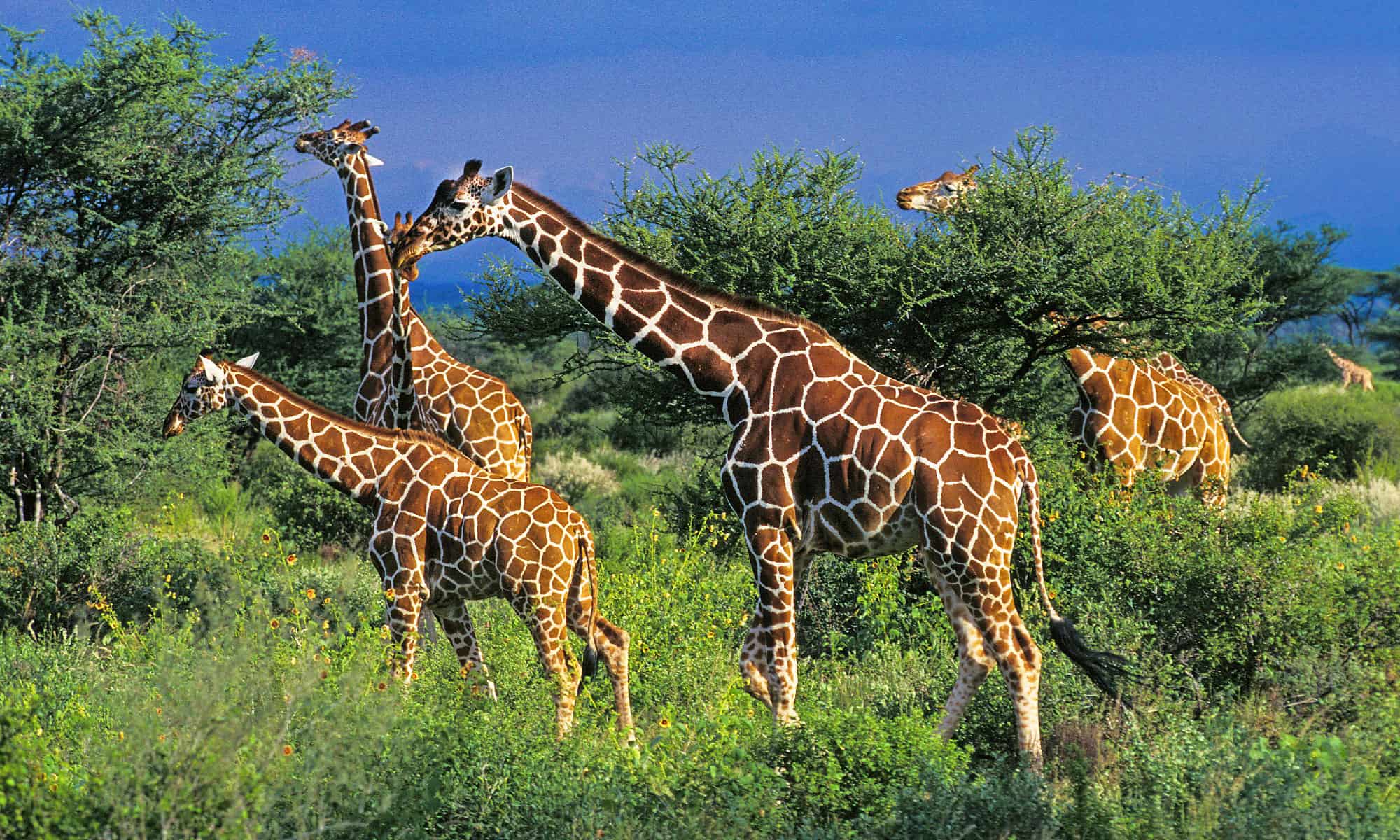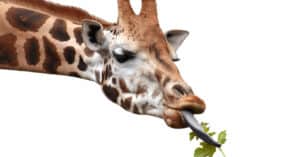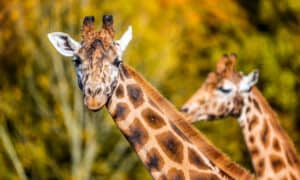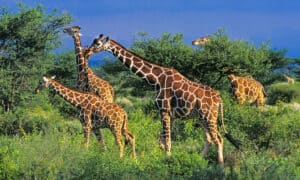Giraffes are truly remarkable creatures, reaching towering heights of 14 to 18 feet. Just the neck alone is taller than most humans, measuring up to 6 feet in length! Undoubtedly, giraffes rightfully claim the title of the tallest animals in the world. However, these majestic giants are also renowned for other reasons, like their exquisite colors. Let’s dive in and take a closer look at the different colors of giraffes, from the rarest hues to the most common shades!
The Purpose of Different Colors in Giraffes
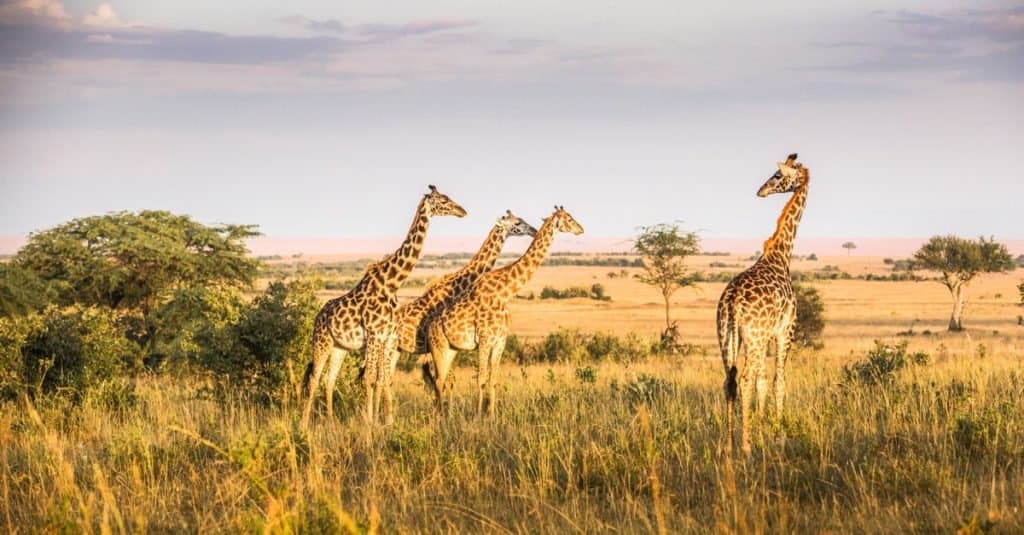
Giraffes are the tallest mammals on Earth.
©Ketan shah/Shutterstock.com
With colors ranging from light tan to black, a giraffe’s coat color and pattern are as distinctive and unique as a human fingerprint! The captivating variations of these exquisite coats are influenced by many different factors, such as individual genetics, species, diet, social status, and surrounding habitat.
Camouflage
Although beautiful, a giraffe’s intricate colors and patterns also play a vital role in its survival. Scientists believe that the colors of a giraffe’s coat serve as a form of camouflage. Their distinctive spots and splotches help to break up their physical outlines and silhouettes, making it incredibly challenging for predators to spot them from a distance. In addition, darker-colored giraffes can hide more easily in shady areas and forests, but giraffes with lighter colors will survive better in dry desert regions.
Thermoregulation
The colors of a giraffe have another superpower — they help to regulate their body temperature! Giraffes live in diverse habitats with varying temperatures, from scorching savannas to cooler grasslands. Each patch of a giraffe’s skin contains a network of blood vessels that branch off into smaller ones. This unique system allows the giraffe to dissipate heat by directing blood flow to the heart of each patch. These thermal windows serve as nature’s solution for releasing the body’s excess heat, illustrating the remarkable adaptations of these astounding creatures.
Communication and Social Status
Giraffes are highly sociable creatures that form herds of 10 to 20 and even up to 50 individuals. Their stunning coats, adorned with intricate patterns and beautiful colors, serve as a means of communication in these groups, reflecting their social hierarchy within the group. Darker hues, for example, not only ensure their visibility amidst the tapestry of the savannah but also signal their prestige and power. Dominant males often utilize their impressive dark coloration to captivate potential mates and intimidate rivals.
Species and Subspecies of Giraffes
There are four distinct species of giraffes and seven to eight subspecies. Although very similar, each type of giraffe has evolved with specific colors and patterns to support the survival of their populations.
| Species | Subspecies | Conservation Status |
|---|---|---|
| Masai giraffe (Giraffa tippelskirchi) | Endangered | |
| Luangwa or Thornicroft’s giraffe (G. t. thornicrofti) | Vulnerable | |
| Masai giraffe (G. t. tippelskirchi) | Endangered | |
| Northern giraffe (Giraffa camelopardalis) | Vulnerable | |
| Kordofan giraffe (G. c. antiquorum) | Critically Endangered | |
| Nubian giraffe (G. c. camelopardalis) | Critically Endangered | |
| West African giraffe (G. c. peralta) | Vulnerable | |
| Reticulated giraffe (Giraffa reticulata) | Endangered | |
| Southern giraffe (Giraffa giraffe) | NA | |
| Angolan giraffe (G. g. angolensis) | Least Concern | |
| South African giraffe (G. g. giraffa) | NA |
Giraffe colors are also affected by their species and genetics. A recent study found that calves inherit certain elements of their spot patterns from their mothers, which helps to improve their chances of survival. For example, mother giraffes play a vital role in transmitting the traits of roundness and smoothness, known as “tortuousness,” to their vulnerable newborn calves. Researchers suggest that there may be a link between the patterns of a giraffe’s spots and the young calf’s survival.
Now, let’s take a closer look at the different colors of giraffes from the rarest to the most common!
1. Spotless
The rarest color of giraffes is spotless — or, in other words, a solid-colored giraffe without any patterns at all! The most recent example of this extraordinary phenomenon occurred in August 2023, when a female reticulated giraffe was born at Bright’s Zoo in Tennessee. The adorable newborn — appropriately named Kipekee (“unique” in Swahellee) — has a velvety brown coat without a single spot in sight!
Notably, Kipekee’s nine-year-old mother, Shenna, has successfully given birth to three other beautiful calves — each covered in typical giraffe spots. So, Kipekee’s spotless coat remains a fascinating enigma, likely resulting from a genetic mutation(s) of some kind. Fortunately, there are no apparent medical concerns or underlying genetic disadvantages affecting this precious and rare reticulated giraffe newborn.
2. White
One of the rarest colors of giraffes is white. Now, you might assume that a white giraffe must have albinism. Albinism is a congenital condition that inhibits the body from producing pigment in all organs. However, there’s actually another genetic condition at play in these stunning white giraffes — leucism. Giraffes and other animals with leucism possess a unique genetic makeup that limits their ability to produce vibrant pigments. However, unlike albinism, even though the skin lacks color, the giraffe’s other organs may still be dark. Leucistic animals will still have dark-colored eyes rather than the pink or red eyes of those affected by albinism.
Tragically, more than half of all giraffes (white or with typical colors) succumb to predators like lions, hyenas, and the devastating impacts of poaching before reaching the age of six months. Remarkably, leucism does not impede their chances of survival. However, their distinctive coloration can inadvertently attract unwelcome attention, endangering their lives more than giraffes with traditional colors. Although it is extremely rare, there have been a few cases of giraffes with leucism, such as Omo, a young white Masai giraffe spotted in Tanzania’s Tarangire National Park in 2015. A few years later, three more white giraffes were seen on a reserve in Kenya.
3. Black
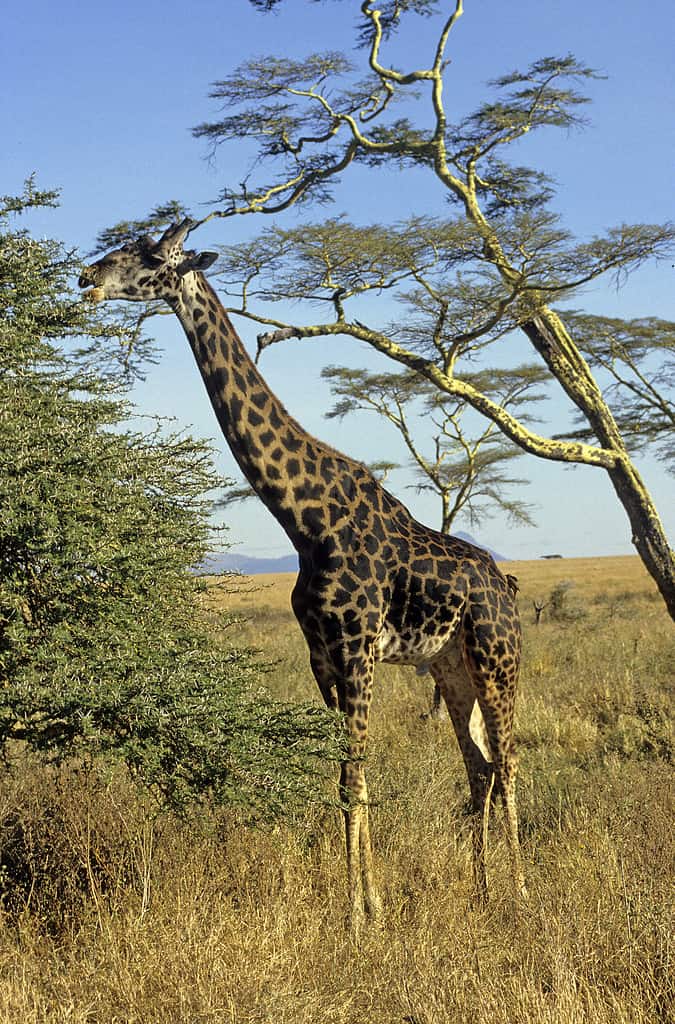
There are only around 600 Thornicroft giraffes in the wild today.
©Michel VIARD/iStock via Getty Images
Found only in eastern Zambia’s South Luangwa Valley, Thornicroft’s giraffe or the Luangwa giraffe (Giraffa tippelskirchi thornicroftii) often has very dark colors. Their irregularly shaped patches range from shades of brown to black, separated by yellowish or white colored bands. As they mature and age, many of these giraffes tend to get darker in color. Some will even transition to having black spots instead of their original color. Possibly driven by testosterone, coat color seems to begin to shift when giraffes are around seven to eight years old. It usually takes a year or two to transition to completely black patches.
However, there are some intriguing exceptions to this trend. A recent study analyzed 66 giraffes and found that, surprisingly, nine of them actually got lighter and paler as they got older, rather than darker! In addition, there were also giraffes that maintained their youthful light coloring and never transitioned to darker black spots.
Researchers observed the behaviors of these lighter and darker giraffes and reported that the dark-hued males had a bold and daring approach to mating. They preferred to go solo, roaming alone as they moved between different groups of giraffes in search of a special someone. It’s a risky strategy, but often successful for these confident males.
In contrast, the paler male giraffes took a different approach. They preferred to stick together in packs with female giraffes. These males played the waiting game, hoping to get lucky when a dominant male was not around.
4. Chestnut

There are only a couple thousand Nubian giraffes in the wild today.
©Nicola_K_photos/Shutterstock.com
The elegant Nubian giraffe (Giraffa camelopardalis camelopardalis) has stunning chestnut-colored spots that are sharp and well-defined, surrounded by white lines. Although all giraffes have extremely long legs, Nubian giraffes have exceptionally long forelegs, which allow them to cover a lot of ground with every step. Even though their galloping rhythm may make them appear slower, this unique advantage actually allows Nubian giraffes to run up to 30 miles per hour!
The Nubian giraffe is one of the rarest subspecies of giraffe, alongside Rothschild’s giraffe (Giraffa camelopardalis rothschildi). It once roamed freely across Northeast Africa, but there has been a shocking 95% decline in its population in the past three decades. Today, wild Nubian giraffes are only found in Southwestern Ethiopia and eastern South Sudan. There are also a few scattered regions of Kenya and Uganda where some isolated populations live as well.
5. Orange
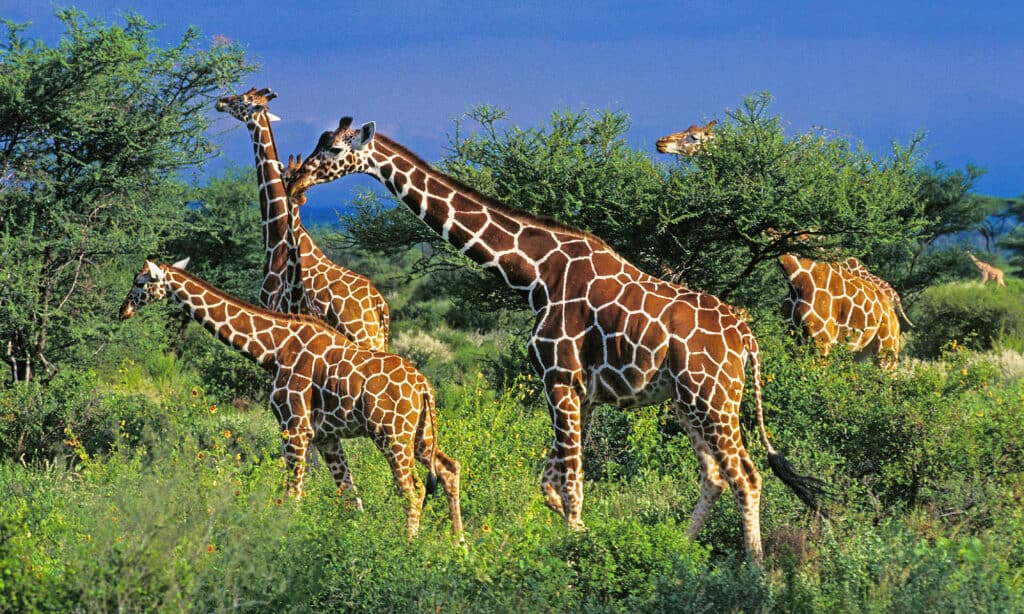
Reticulated giraffes are native to Somalia, Southern Ethiopia, and Northeastern Kenya.
©iStock.com/slowmotiongli
Orange is another common color that you will see on many giraffes, such as the reticulated giraffe (Giraffa reticulata). Native to the Horn of Africa, the reticulated giraffe is the most common giraffe species you’ll see at zoos and animal parks. Their beautiful and striking patterns make them stand out, with large brown or brown-orange patches delicately outlined by thin white lines. These intricate patches are often irregular in shape, and some may even appear fused together.
6. Brown

The lower legs of South African giraffes are speckled randomly with spots of various sizes.
©Stefan Scharf/Shutterstock.com
There are two subspecies of the Southern giraffe, which both exhibit brown coloring. The first, the South African giraffe (Giraffa giraffe giraffa), boasts a stunning coat with brown patches of various shades set against a rich tawny or light brown background. The giraffe’s distinctive spots are either rounded or have star-like protections, gracefully extending from the main body down its long legs as they gradually become more haphazard and smaller in size.
The second subspecies of the Southern giraffe is the Angolan giraffe (Giraffa giraffe angolensis), which has big brown blotches on its body. These blotches have edges that are a little bit wavy or have pointy parts sticking out. The spots go all the way down to its legs, but not on its face. The patches on its neck and rear end are pretty small compared to the rest. Angolan giraffes are usually a light color, and in arid regions like northwest Namibia, they can appear to be almost completely colorless!
Native to East Africa, Masai giraffes (Giraffa tippelskirchi) also have brown splotches that are much more jagged. In fact, these spots almost look like erratic leaf patterns covering the giraffe’s body. Their colors are also typically darker than other giraffe species.
7. Tan
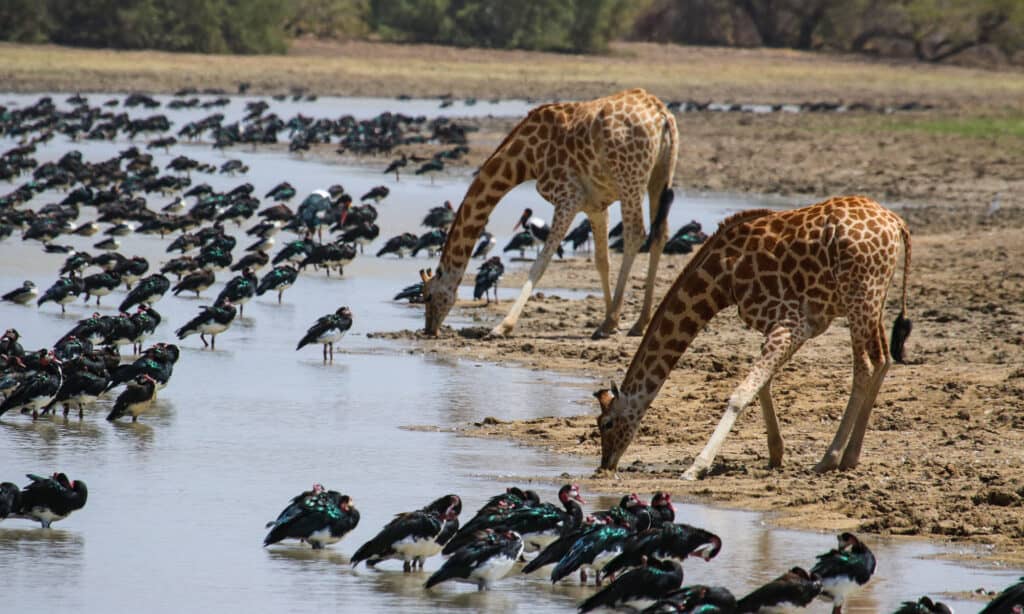
Kordofan giraffes are smaller giraffes, measuring about 12.5 to 15.5 feet.
©Thomas Clode/Shutterstock.com
The predominant and most common color you’ll see on a giraffe is tan, a lovely hue that typically serves as a backdrop for their distinctive colored spots. The southern giraffe (Giraffa giraffa), for example, is the most abundant giraffe species and lives across the plains of southern Africa, stretching from Angola to South Africa. Its beautiful tan coat is patterned with intermittent, elongated spots, which come in various shades of brown, black, orange, or cream.
The critically endangered Kordofan giraffe (Giraffa camelopardalis antiquorum) also has pale tan or brown patches with unique, irregular shapes. The patches gradually get smaller as they travel down the giraffe’s legs until they disappear completely.
Thank you for reading! Have some feedback for us? Contact the AZ Animals editorial team.

